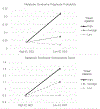Threat vigilance and socioeconomic disparities in metabolic health
- PMID: 29162180
- PMCID: PMC6541228
- DOI: 10.1017/S0954579417001353
Threat vigilance and socioeconomic disparities in metabolic health
Abstract
A quarter of the global population meets diagnostic criteria for metabolic syndrome (MetS). MetS prevalence stratifies by socioeconomic status (SES), such that low SES is associated with higher MetS risk starting in childhood. Despite this trend, some low-SES children maintain good metabolic health across the life span, but the factors responsible for their resilience are not well understood. This study examined the role of threat vigilance as either a moderator or a mediator of the effects of low early life SES on adult metabolic risk. Three hundred twenty-five Canadians aged 15-55 participated (M = 36.4 years, SD = 10.7; 55.4% female). We coded parental occupational status between the ages of 0 and 5 to index early life SES. We used the International Diabetes Federation case definition for MetS based on waist circumference, blood pressure, triglyceride levels, HDL cholesterol, and glycosylated hemoglobin measures. Threat vigilance was assessed using the Weapons Identification Procedure, a visual discrimination paradigm that captures implicit perceptions of threat. Analyses supported the moderator hypothesis: low early life SES was associated with MetS diagnosis exclusively among those with high levels of threat vigilance. This suggests that low early life SES environments that heighten vigilance to threat might be particularly detrimental for metabolic health. Conversely, low threat vigilance may buffer against the metabolic risks associated with socioeconomic disadvantage.
Figures
Similar articles
-
Early-Life Socioeconomic Disadvantage and Metabolic Health Disparities.Psychosom Med. 2017 Jun;79(5):514-523. doi: 10.1097/PSY.0000000000000455. Psychosom Med. 2017. PMID: 28178032 Free PMC article.
-
Relationship between socioeconomic status and metabolic syndrome among Nigerian adults.Diabetes Metab Syndr. 2013 Apr-Jun;7(2):91-4. doi: 10.1016/j.dsx.2013.02.014. Epub 2013 Mar 14. Diabetes Metab Syndr. 2013. PMID: 23680248 Clinical Trial.
-
Childhood Socioeconomic Status in Predicting Metabolic Syndrome and Glucose Abnormalities in Adulthood: The Cardiovascular Risk in Young Finns Study.Diabetes Care. 2016 Dec;39(12):2311-2317. doi: 10.2337/dc16-1565. Epub 2016 Oct 18. Diabetes Care. 2016. PMID: 27797929
-
Percentage of Body Fat and Fat Mass Index as a Screening Tool for Metabolic Syndrome Prediction in Colombian University Students.Nutrients. 2017 Sep 13;9(9):1009. doi: 10.3390/nu9091009. Nutrients. 2017. PMID: 28902162 Free PMC article.
-
Childhood fitness reduces the long-term cardiometabolic risks associated with childhood obesity.Int J Obes (Lond). 2016 Jul;40(7):1134-40. doi: 10.1038/ijo.2016.61. Epub 2016 Apr 22. Int J Obes (Lond). 2016. PMID: 27102049
Cited by
-
Protective factors for youth confronting economic hardship: Current challenges and future avenues in resilience research.Am Psychol. 2019 Sep;74(6):641-652. doi: 10.1037/amp0000520. Am Psychol. 2019. PMID: 31545638 Free PMC article. Review.
-
Sexual Minority Identity and Risky Alcohol Use: the Moderating Role of Aggressive Behavior.J Youth Adolesc. 2025 Jan;54(1):196-208. doi: 10.1007/s10964-024-02057-9. Epub 2024 Jul 22. J Youth Adolesc. 2025. PMID: 39037558
-
Anxious to see you: Neuroendocrine mechanisms of social vigilance and anxiety during adolescence.Eur J Neurosci. 2020 Jul;52(1):2516-2529. doi: 10.1111/ejn.14628. Epub 2019 Dec 20. Eur J Neurosci. 2020. PMID: 31782841 Free PMC article.
-
Explaining the Relationship Between Minority Group Status and Health Disparities: A Review of Selected Concepts.Health Equity. 2019 Mar 7;3(1):47-60. doi: 10.1089/heq.2018.0035. eCollection 2019. Health Equity. 2019. PMID: 30868139 Free PMC article. Review.
-
Metabolic syndrome traits exhibit genotype-by-environment interaction in relation to socioeconomic status in the Mexican American family heart study.Front Genet. 2024 Mar 1;15:1240462. doi: 10.3389/fgene.2024.1240462. eCollection 2024. Front Genet. 2024. PMID: 38495670 Free PMC article.
References
-
- Ainsworth MDS, Bell SM, & Stayton DJ (1974). Infant–mother attachment and social development: Socialisation as a product of reciprocal responsiveness to signals In Richards MPM (Ed.), The integration of a child into a social world (pp. 99–137). New York, NY: Cambridge University Press.
Publication types
MeSH terms
Grants and funding
LinkOut - more resources
Full Text Sources
Other Literature Sources
Medical


